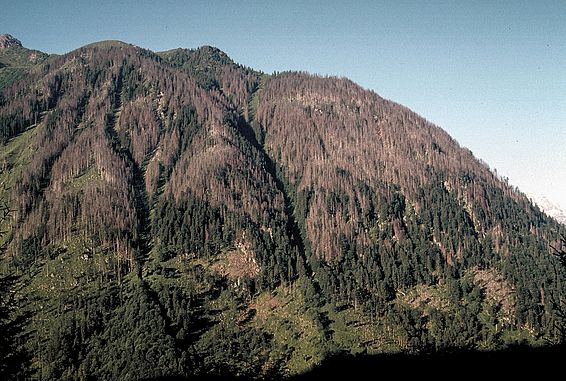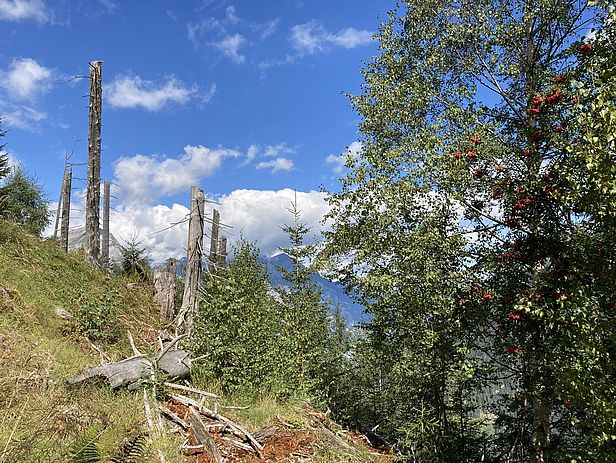25.08.2022 | Christine Huovinen | News SLF
The SLF's Mountain Ecosystems research group investigates how climate change and changes in land use are affecting habitats above and below the treeline. Forest, with its protective function against natural hazards, is particularly impacted.
The SLF showcases the research groups of the Climate Change, Extremes and Natural Hazards in Alpine Regions Research Centre CERC, in no particular order. Founded in 2021, the CERC is sponsored by the Canton of Grisons and the Swiss Federal Institute for Forest, Snow and Landscape Research WSL and is supported by ETH Zurich. It is part of the SLF in Davos.
Flower-rich alpine meadows, scree slopes, alpenrose stands and coniferous forests – the SLF Mountain Ecosystems research group, part of the CERC, focuses on habitats extending from mountain forests up to the highest peaks. All have to endure a harsh mountainous environment, characterised by large amounts of snow, extreme temperatures, avalanches, and so on. In general, the habitats and the animal and plant species that live in them cope well. However, they are facing a growing challenge because of climate change and declining use of the alps. Ultimately, humans are also affected by this: mountain ecosystems attract tourists, feed cows, prevent the triggering of avalanches and protect against rockfall, among other functions.
Increase in bark beetle infestation ¶
One of the focal topics of the Mountain Ecosystems research group is mountain forests and their protective function against natural hazards. For example, the researchers are investigating how bark beetle outbreaks affect protection forest, including on Gandberg in the canton of Glarus. Peter Bebi, the head of the research group, says: "A drier and warmer climate is increasingly leading to large-scale beetle infestations, especially in spruce, and the death of entire forests. Gandberg is one of the few forest stands that were infested back in the 1990s and were not cleared afterwards. This makes the area ideal for studying the long-term effects of bark beetle damage." Based on measurement series taken directly in the forest, remote sensing data and avalanche simulations, the researchers concluded that forests affected by bark beetle often provide better protection than is generally assumed. This protection was at its worst 15 years after beetle infestation because there were so many gaps in the forest, but improved again after that as new saplings emerged.
Tools for practitioners ¶
But what do these research results mean in practice? "Although beetle-infested trees continue to offer some protection, it's important to identify at an early stage which trees are susceptible to infestation and where firm action is need to combat it. This prevents the beetle from spreading further and increasingly weakening the protection forests," explains Bebi. Together with the SLF's Alpine Remote Sensing group, other WSL groups and the Canton of Grisons' Office for Forest and Natural Hazards, Bebi's team is currently working on some basic tools for monitoring infestations of bark beetles and the hazard posed by these insects in the canton. The benefits for practitioners are particularly important to him: "Through our work, we want to provide decision-makers with the tools they need to prioritise their forest and natural hazard management measures in an informed way."
Contact ¶
Links ¶
Copyright ¶
WSL and SLF provide the artwork for imaging of press articles relating to this media release for free. Transferring and saving the images in image databases and saving of images by third parties is not allowed.



